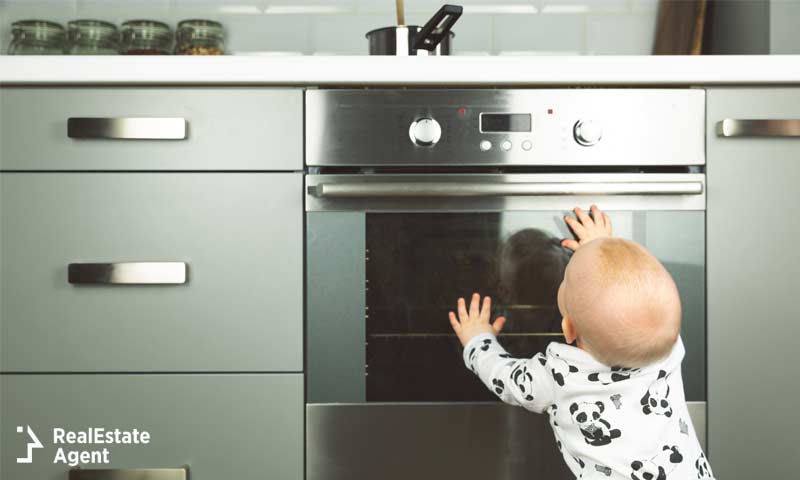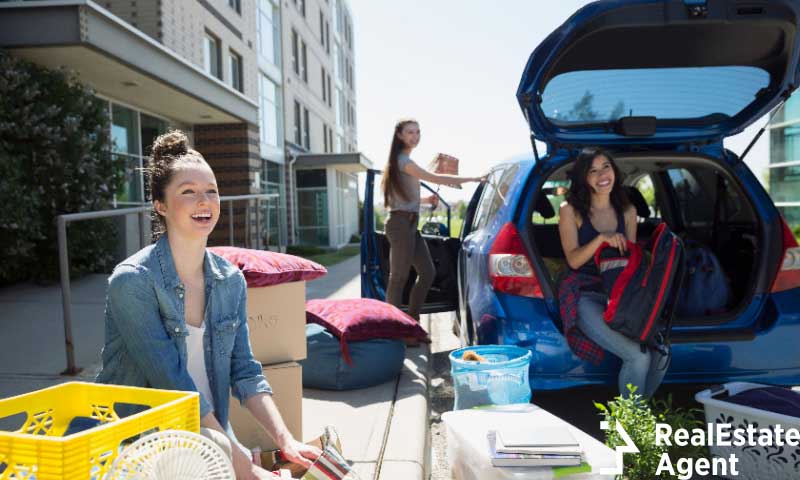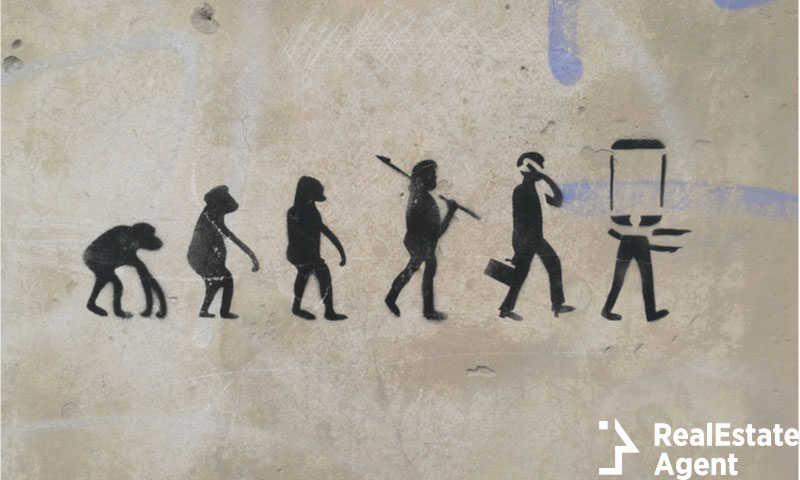Four million babies are born in the US every year! Parents who are having their first child can’t wait to see their baby reach a new milestone in his or her development. The most expected milestone is walking. Once the baby begins to walk alone, parents also begin to worry and look for baby proofing ideas. All children born in 2015 – 3,978,497, according to CDC – will turn four this year and our team at RealEstateAgent.com has decided to ask a few young parents about the challenges they’ve had to face during the past years regarding child safety. What did they do in every room to make sure they don’t have to watch their kids like Big Brother? Let’s find out!
When should you baby proof your house?

To better understand the need for childproofing, we have to find what we should expect from a baby. We call “baby” a child from birth up to two months. Infants are children between two and 12 months, while toddlers are between 1 and 4 years of age. However, we often refer to all these groups as babies. So, what are the main milestones?
- 3 months – the baby begins to smile and his movements become more purposeful and better coordinated
- 4 months – babies start to laugh and you can see how they try to reach the objects in front of them
- 6 months – the baby sits up alone
- 6-9 months – some babies begin to crawl and stand themselves up by holding on to the couch or coffee table
- 12 months – walking begins, although some children don’t walk before 15 or 18 months. Now they start to move objects and toys around.
- 18 months – babies are full of energy at this age and will copy your actions and words.
- 36 months – at this age, toddlers want to know how everything works and start asking lots of questions.
Most of us have grown up in homes with minimal or no childproofing. It was not such a big deal if we showed up with bruises and scratches. As adults, we have learnt from our mistakes and came up with all these baby proofing ideas and products, but let’s not forget that we also used to be more active and more obedient than new generations. An article published by Psychology Today revealed that French toddlers are much more disciplined and compliant than the ones in the US. They would sit and eat peacefully at a table, like grownups. A comparison of crime in the OECD (Organisation for Economic Co-operation and Development) countries revealed that there are three times more cases of intentional homicide in the US than in France.
Overall, kids are becoming more disobedient. We know that we are born with a tendency to do what’s wrong instead of what is good and through education we can become an individual with a better moral, but the bad nature is still within us and could be fueled by high-sugar diets, hormones or steroids intake, TV shows and movies, video games, traumas, or psychiatric disorders. You may wonder now who had it harder – you or your parents. Do you think it was easier to raise a baby twenty or thirty years ago?
Whether it was easier for your parents to raise you or not, you still have to take good care of your baby. So you may start looking for baby proofing ideas for your house as soon as your pregnancy test shows two lines. When newlyweds find a real estate agent and start looking for a new house, they usually have a remodeling plan in mind for a baby nursery. Fortunately, there is no hurry in wrapping all the house in bubble wrap. You can wait until the baby starts to stand up by him/herself. However, there is no hard and fast rule – we believe that every parent knows or feels when is the right time. Besides this, we all have friends who have already been through this so they’ll have many baby proofing ideas to share with us.
Childproofing the kitchen

Kitchens are full of more or less obvious dangers, so baby proofing ideas for this room are aplenty. Small kids are fascinated by drawers and cabinet doors and they’re so proud of their ability to open them by themselves. Of course, as their parents, we are proud of them too, but it’s better to keep them away for the moment. Let’s not imagine the worst that could happen if they open the drawer with all the sharp kitchen utensils.
Don’t underestimate the high chair injuries. U.S. emergency rooms receive more and more cases of injuries caused by high chairs every year – from 9,299 in 2013, the number rose to 12,101 cases in 2017, according to kidsindanger[dot]com. Most accidents involve babies under age one. How to prevent these incidents? First of all, use the restraints. Then, check for any screw heads that are not covered or sharp pieces of plastic your child could rub up against.
When cooking, never keep pan handles out and try to use the back burners when cooking. Buy stove knob covers to prevent kids from turning the gas on. If you keep chemicals underneath the kitchen sink, make sure you put a child proof lock on the doors of that cabinet, too. Almost half of poison exposures occur in children younger than 6 years, most of them being unintentional. One and two years old babies are at higher risk of poisoning, especially boys and the main poisons are found in cosmetics and personal care products, cleaning substances and analgesics.
Should you leave any cabinet doors open? Yes, but only if you store toys there so that the child gets some satisfaction from opening those doors.
Childproofing the bathroom

Children can drown in an inch of water, so you have to stay with your child all the time and watch how he/she plays in the bathtub. If the phone rings in another room or if someone knocks at the door, first, you take the baby out of the bathtub and then answer. The bath water’s temperature should be the same as the body temperature, around 100 degrees Fahrenheit. Put your baby with his/her back to the faucet so that he/she won’t play with it and open the hot water by mistake. Use a toilet lock for the toilet lid, as well. Always close the door behind you and as extra protection, you can use a door knob cover. Keep all the buckets in your bathroom empty and out of the child’s reach.
When childproofing the bathroom be extremely cautious about your medication. Keep all drugs in their original containers, preferably with child-resistant tops, and lock them in a cabinet with a child-safety lock. According to the National Poison Data System, analgesics are the main culprit in pediatric fatalities.
Childproofing the stairs

Maybe you used to slide down the handrail carelessly as a child but believe us – that’s not what you want from your child. You might love your staircase and its design, but when you have a child, the design comes second, and for safety reasons, you might have to cover it. There are different materials that can be used to cover the railing, some of them transparent or translucent. A great idea would be to install a baby gate – some of these don’t even require drilling. When you don’t have stairs in your house, you have one less thing to worry about. One story houses are easier to manage, especially if you spend a lot of time at home with the baby. You can move to a two story house when the child grows up.
Childproofing the bedroom

Children spend a lot of time in their parents’ bedrooms (I’d dare say too much time) and most of them enjoy jumping on the mattress, dancing or doing acrobatics worthy of Cirque du Soleil. When choosing a bed for your master bedroom, make sure it has a soft headboard and cover corners with foam or silicone edge protectors. Dressers should be tethered to the wall, as for the drawers, install latches so that your child won’t open them and use them to climb. If your child slams a drawer, there is also the risk of fractures in finger bones. Statistics don’t look good at all – every hour, one child is admitted to the ER after being caught under a heavy object.
Now, look at the sockets because they might need an upgrade. Use the ones that slide and cover the openings when not in use or even a socket cover with a plastic cage. Cover the cables from fixed appliances with a cable concealer as well.
If you have a changing table in your bedroom, don’t keep cosmetic products such as baby oil or baby powder underneath – in some cases, children ingested them and ended up intoxicated or even died. Store them in a locked drawer in the bathroom or above the changing table. Also, keep the shelves clean and clear of small objects that could pose a choking hazard.
Childproofing the living room

The main challenge in modern condos and houses is the open space – the kitchen, the dining area and the living room are connected which calls for some creative baby proofing ideas. For example, you may use a fence with a baby gate to separate the living room and prepare a playing area with some colorful play mats and a toy house. Then, if you have a coffee table, you may either use corner guards or replace it with an ottoman. An ottoman may serve both as a seat and a table, but it also provides plenty of storage space for whatever you want to keep out of your baby’s reach. You may also want to hang the TV on the wall or incorporate it in your living room furniture.
Next, be aware that some house plants can be extremely toxic – for example, the milky sap of Euphorbia pulcherrima is poisonous and could irritate the skin and eyes. Oleander is also very toxic – eating only one leaf could kill a child. Plants are great air purifiers so you don’t have to get rid of them immediately. You may want to put them on a high window sill or on a high plant stand that has good stability or one that is secured to the floor.
Childproofing a garden shed

If you’re growing vegetables around the house you probably have a garden shed or a place where you store all your gardening tools, pesticides, and fertilizers. Hoes, rakes, forks, shears, and scissors should be carefully stored while any pesticides and fertilizers should be locked in a cabinet or drawer. Children will get curious and will want to help you at some point, however, don’t use any toxic substances in their presence.
Childproofing the backyard

Always keep your main door closed so that your kid(s) don’t get out on the street without your consent and supervision. Burglars usually wander around to spot the yards with easy access, so you don’t want to draw attention to your property. Have surveillance cameras installed outside, too, and especially at the front door. Some thieves are specialized in stealing the parcels left at your door.
Do you want your kids to play safely outdoors? When you design a play area for your children outdoors, surround it with a fence. Also, if you have a pool in your backyard, install a fence around it, too. If you grow roses or cacti, make sure your kids admire them from a distance. However, keep a first aid kit handy. Trim the grass and weeds, especially the nettle in your garden, but you might have other toxic plants there as well so try to identify them.
Establish the relationship between your kids and your guard dog, if you have any. Are they allowed to play with it or is the species too aggressive? Maybe you should buy other cool pets for your children such as birds, turtles or rabbits. Childproofing is not about constraining, but about giving your child the freedom to enjoy the things he/she would normally do without putting his/her life in danger.
After reading all these baby proofing ideas, you might still feel that you need some help. Did you know that there are certified professional childproofers who specialize in making houses safer for children? A simple consultation costs between $50 and $100, while child-proofing your house could cost anywhere between $500 and $1,500. But is it really worth childproofing your entire house instead of teaching your kid to listen? Turning your house into an escape room could trigger feelings of guilt for some mothers, but after all, by protecting your child you’re doing yourself a favor – you have more time left for playing not yelling.









